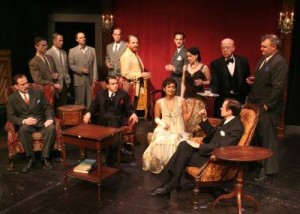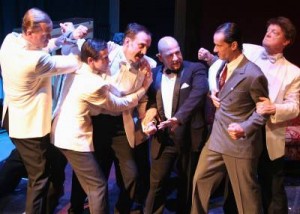
Twentieth century history comes vividly to life in Michael Franco’s fascinating
(and informative) world premiere drama, The Room.
The year is 1927, the place is the fabled El Morocco nightclub in New York City,
and the characters have some of the most famous names of the past century.
There is Vincent Astor, son of gazillionaire John Jacob Astor (who went down on
the Titanic); Kermit Roosevelt, son of President Teddy, cousin of President Franklin;
Marshall Field, son of the department store magnate; Nelson Doubleday (you’ve
probably read books his company published); and others. Prohibition is the law,
though the rich can easily ignore it. The stock market is soaring (though the
crash is just two years away). And far away, in Europe, there looms a double
threat—Communism in the Soviet Union and Nazism in Germany.
These men’s informal get-togethers gradually become meetings with the
purpose of gathering and sharing of intelligence, the seeds of today’s CIA.
“That’s for the experts,” protests one of the men, to which another replies, “The
experts are in this room.”
Through the magic of live theater, the large and appropriately high-ceilinged
stage at the Open Fist Theatre becomes the elegant setting for Franco’s drama
about money and power and politics, a story that doubtless continues to this
day, behind the scenes, behind closed doors.
It seems hard to believe, given the wisdom of hindsight, that America in the
thirties saw little threat being posed by Adolph Hitler. The men in the room
viewed Communism as the greater danger (as it was certainly viewed from the
1950s up to the fall of the Soviet Union). Anyone (at the time The Room takes
place) who worried about the threat of war with Germany was called “overly
dramatic.” As one character puts it, the Germans didn’t threaten us because
they looked like us. Communists seemed to pose a more serious threat because
it was an economic system we did not understand and therefore feared.
The men (and occasionally women) who met in the titular room have been
brought to three-dimensional life by writer/director Franco and by the actors
who portray them.
The finest performance of the evening (and the most complexly fascinating
character) is that of John Gegenhuber as Kermit Roosevelt. The black sheep of
the family, Kermit seems always to have a joke on his lips and a martini glass in his
hand. “I’m sharper than I let on,” he comments, certainly an understatement,
given that he is often the only one in the room who sees what’s truly happening
in the world and isn’t afraid to speak his mind about it. In one particularly
powerful scene, Kermit has a confrontation with a German Nazi couple at El
Morocco which very nearly ends up a duel.
There is also philanthropist Vincent Astor, who had a heart as big as the fortune
his magnate father amassed, who considered the family servant Dalton to be his
true father, who understood the irony of rich men complaining about the evils of
money, and whose mission in life was to give away the fortune his father made.
Vincent, a “kind, decent man, maybe too decent for the world as it is,” decided
that he woulf “no longer sit around and let this world go to crap.” The role is
played by Shawn MacAulay, who although seeming a bit hesitant with some of
his lines on opening night, gave a performance which gained strength as the
evening progressed.
Dylan Maddalena is also very good as the handsome young Marshall Field III.
Maddalena, particularly, has the voice and posture of a well bred gentleman of
the 1930s down pat, as do most of the huge cast. Among the women, Amanda
Weier, so good in the recent The Idiot Box, gives a pitch perfect performance of
the oh so elegant and refined (and brilliant) journalist Dorothy Thompson,
among the first to write about the lies that Hitler was telling. Rebecca Rosenak
does excellent double duty as Sophie, one of Astor’s loyal servants, and as Greta,
a Nazi beauty with a not so beautiful soul.
Though not all performances have gelled yet, most of the very large cast acquit
themselves admirably. I particularly liked Michael McGill’s work as William
Donovan, the millionaire head of the OSS, Stephanie Terronez as the elegant
Baroness Hatvany, Bjorn Johnson as a very British Somerset Maugham, Marcus
Maria Jung as slick and slimy Nazi Hans Groeniger, and Donna Giffen as
chanteuse Marion Myles.
Giffen, backed by Alexander Burke on piano and vibes, and Aubrey Torres on
bass, sings a dozen or so between-scene songs of the era, wearing just as many
glamorous gowns. Her songs, which include Side by Side, Makin’ Whoopee, Get
Happy, Someone to Watch Over Me, Blue Skies, Ain’t Misbehavin’, and Bi Mir Bist
Du Shon, allow for set changes just as they set the mood of the era. Her gowns,
which reflect the changing fashions of the 20s and 30s, were designed by Diane
Crooke, who also selected the mens’ costumes, era-perfect down to their shoes.
The production is not without flaws. A few of the scenes come across a tad
static, with a dozen or so characters just sitting around a table conversing, and
at least one somewhat superfluous scene involving Astor’s angry and frustrated
wife (he would seem to have preferred the company of other men) could just as
easily have been left “on the cutting floor,” but on the whole Franco and
company, can be proud of this one-of-a-kind production, especially for a 99-seat
theater.
As history, as drama, and as just plain good theater, The Room mostly succeeds,
and often quite well, in addition to making the audience want to learn more
about these characters and the time in which they lived, a time which in many
ways is sadly not so different from the one we live in today.
Open Fist Theatre, 6209 Santa Monica Blvd. , Hollywood.
www.openfist.org
–Steven Stanley
September 28, 2007




 Since 2007, Steven Stanley's StageSceneLA.com has spotlighted the best in Southern California theater via reviews, interviews, and its annual StageSceneLA Scenies.
Since 2007, Steven Stanley's StageSceneLA.com has spotlighted the best in Southern California theater via reviews, interviews, and its annual StageSceneLA Scenies.







 COPYRIGHT 2024 STEVEN STANLEY :: DESIGN BY
COPYRIGHT 2024 STEVEN STANLEY :: DESIGN BY